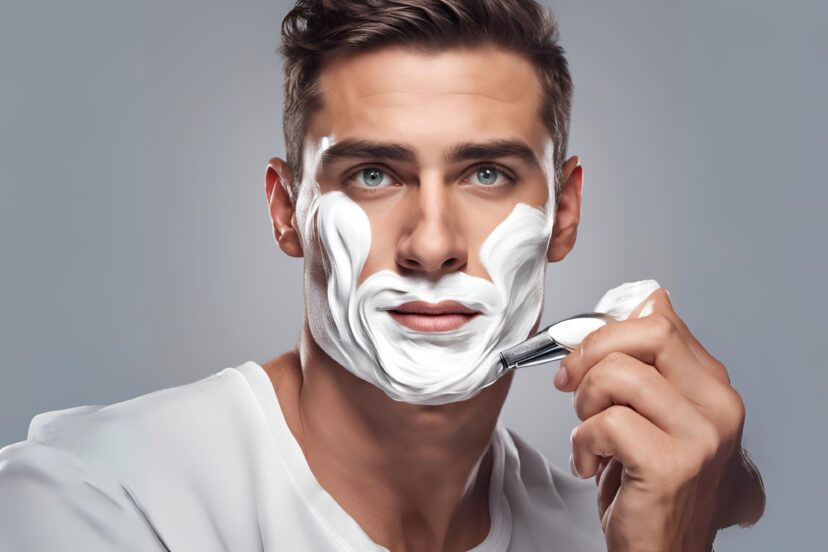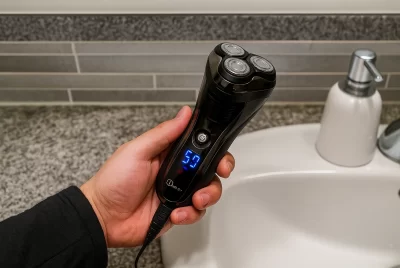How to Apply Shaving Cream: Best Techniques Revealed
Post Disclaimer
*We may earn a commission for purchases made using our links. Please see our disclosure to learn more.
Struggling with razor burns and uneven shaves? Shaving cream is a game-changer. This article will guide you for how to apply shaving cream, ensuring a smoother shave.
Discover the secrets to perfect skin preparation and facial grooming now!
Benefits of Using Shaving Cream
Using shaving cream hydrates the skin and provides a protective layer, softening facial hair to reduce irritation. The application of shaving cream ensures a smoother, more comfortable shave while protecting the skin from potential damage.
Provides hydration
Applying shaving cream is a crucial step in the facial grooming techniques for achieving smooth skin. It helps maintain the skin’s moisture, ensuring it stays hydrated throughout the shaving routine.
This hydration is essential because it prevents the skin from becoming dry and irritated, making facial hair removal more comfortable and effective.
Shaving cream acts as a barrier between the blade and your skin, allowing for a smoother glide during each stroke. This not only improves your wet shaving experience but also minimizes the chances of cuts and nicks.
Keeping the skin well-hydrated aids in softening facial hair, which makes it easier to cut through with less force required from your razor.
For anyone involved in personal care or men’s skincare, understanding that proper hydration leads to healthier-looking skin post-shave is vital. Hydrated skin heals faster, reducing redness and irritation that often accompany shaving with dry or improperly prepared skin.
Always choose a quality shaving foam or gel that complements your shaving technique for optimal results.
Creates a protective layer
Shaving cream creates a protective layer on the skin, safeguarding it from nicks and cuts during the shaving process. This protective barrier also helps to reduce friction between the razor and skin, leading to a smoother and more comfortable shaving experience.
The protective layer formed by shaving cream acts as a shield against potential irritation and redness that can occur during or after shaving. By applying a small amount of cream on damp skin before shaving, this layer ensures that your skin is well-prepared for a clean, close shave without causing any damage.
Creating a protective layer with shaving cream not only enhances your comfort but also shields your skin from potential irritations.
Softens facial hair
Shaving cream is essential for a smooth and comfortable shave. It works by softening facial hair, making it easier to cut during shaving. This not only reduces the risk of nicks and cuts but also ensures a closer shave.
By using shaving cream, you can prepare your facial hair for a more effective and efficient removal process.
Using shaving gel or brush along with proper techniques enhances the benefits of softening facial hair, providing an optimal experience while removing unwanted hair from your face.
Reduces irritation
Using shaving cream can reduce irritation by providing a protective layer and lubrication for your skin. This helps the razor glide smoothly and prevents it from causing friction, leading to redness or razor burn.
Additionally, the hydration provided by the shaving cream softens facial hair, making it easier to shave without tugging at the skin. Choosing a quality shaving cream with moisturizing properties can further minimize irritation and leave your skin feeling smooth and comfortable.
Properly applying shaving cream is essential in achieving a comfortable shave while reducing irritation. Using the right techniques ensures that you get the most benefit from your chosen product.
The next section will focus on “Steps to Properly Apply Shaving Cream.
Steps to Properly Apply Shaving Cream
To properly apply shaving cream, wet the shaving area, use a shaving brush to lather in circular motions, and leave it on for a few minutes for optimal hydration and protection. For more tips on achieving a close shave, read on.
Wet shaving area
Before you start shaving, it’s essential to wet the shaving area with warm water. This helps to soften the hair and open up the pores, making it easier for the razor to glide smoothly across the skin.
Gently pat your face dry after wetting the area.
To maximize the benefits of using a shaving cream, ensure that your skin is adequately moistened before application. This not only prepares your facial hair for a closer shave but also reduces any potential razor burn or irritation.
Soaking your skin in warm water softens both hair and skin, promoting an effortlessly smooth shave.
Using warm water on your face can make a significant difference in your shaving experience. It’s an important step that should not be overlooked when aiming for a comfortable and effective shave.
Use a shaving brush
To apply shaving cream effectively, use a shaving brush. This will help you create a rich lather and ensure an even application of the cream onto your skin. Apply a small amount of cream to the tips of the brush and then lather it onto your face using circular motions.
The bristles help exfoliate the skin and lift facial hair for a closer shave, making it an essential tool for proper shaving preparation. Whether you’re male or female, incorporating a shaving brush into your grooming routine can significantly improve your overall shaving experience.
By using a shaving brush, individuals can achieve better results when applying their chosen pre-shave product to prepare their skin prior to removing facial hair.
A quality shave brush is recommended equipment that helps distribute product more evenly over larger surface areas than just one’s fingertips alone would allow.
Apply a small amount of cream
Using a small amount of shaving cream is key for a smooth shave. Gently squeeze a dime-sized portion onto your fingertips or directly onto the wet shaving area. Remember, less is more when it comes to applying the cream, as excessive product can lead to clogged razors and an uneven shave.
Simply spread the cream in gentle circular motions to create an even layer on your skin before lathering with a brush.
Lather in circular motions
After applying a small amount of cream to the shaving area, it’s time to lather in circular motions. This technique helps evenly distribute the shaving cream and lifts the facial hair for a smoother shave.
The circular motions also help create a rich lather, ensuring that your skin is adequately protected during shaving. By using this method, you can effectively prepare your skin and facial hair for a comfortable and precise shave.
Using gentle pressure while lathering in circular motions promotes an even application of the shaving cream, providing better coverage across all areas of the face or body being shaved.
This step not only ensures proper hydration but also aids in softening the facial hair, making it easier to achieve a close shave with minimal risk of irritation or razor burn. Embracing this simple yet essential step sets the stage for a successful and satisfying shaving experience.
Leave on for a few minutes
After lathering the shaving cream onto the skin in circular motions, it is beneficial to leave it on for a few minutes. This allows the shaving cream to soften the hair follicles and hydrate the skin further, facilitating an easier shaving experience.
By leaving the shaving cream on for a short duration, you optimize its effectiveness before commencing with your shave. This simple step can make a noticeable difference in how smooth and comfortable your shave feels.
Leaving the shaving cream on for a brief period also gives it time to create a protective layer over the skin, reducing irritation and redness that may occur during or after shaving.
This short wait contributes to achieving optimal results from your grooming routine while promoting healthier-looking skin.
Proper Shaving Techniques
Use a sharp blade and shave in the direction of hair growth, ensuring to rinse the blades often for a smooth shaving experience. If you want to discover more detailed techniques and tips, click here.
Check for dull blades
Dull blades can cause nicks and irritation, so it’s crucial to check them before shaving. Inspect the blade carefully for any signs of dullness, such as rust or pitting. If the blades tug at your hair or feel rough against your skin, they may need to be replaced.
Using sharp blades ensures a smoother shave and reduces the risk of razor burn or ingrown hairs.
Inspecting your razor for dullness is essential to avoid discomfort and achieve a clean, precise shave. Regularly replacing dull blades guarantees an effective and comfortable shaving experience.
Shave with light, gentle strokes
Apply the shaving cream generously to create a protective layer. Wet your face with warm water before using the razor for a smoother shave. Glide the razor gently in the direction of hair growth to avoid irritation and achieve a clean, close shave.
Rinse your blade often throughout its use to prevent clogging and maintain sharpness. Utilize precision trimmers for shaping facial hair edges and maintaining overall grooming.
Consider incorporating aftershave or moisturizer to soothe your skin after shaving. Employ these techniques regularly to master the art of shaving with ease and confidence.
Moving on from proper shaving techniques, let’s explore post-shave care tips that support healthy skin as part of your grooming routine.
Rinse blades often
After each stroke, rinse the blades thoroughly to remove any built-up shaving cream and hair. This ensures a clean blade for the next pass, preventing tugging and irritation.
Rinsing the blades often also prevents clogging, leading to a smoother shave without having to re-go over areas multiple times. It’s an essential step in maintaining a clean and sharp razor for an optimal shaving experience.
Consider creating a habit of rinsing your razor after every few strokes for best results.
Shave in the direction of hair growth
For a smoother shave and to minimize irritation, it is crucial to shave in the direction of hair growth. This technique helps in reducing ingrown hairs and prevents razor burns. Shaving with the grain also ensures that you achieve a closer and more comfortable shave, leaving your skin feeling smooth and free from irritation.
Next: Post-Shave Care
Use precision trimmer for edges
After shaving in the direction of hair growth, it’s essential to use a precision trimmer for edges. This crucial step ensures that you achieve a clean and well-defined finish. The trimmer allows you to shape and neaten up smaller areas such as sideburns, mustaches, and the edges of your beard or goatee with accuracy.
The precision trimmer for edges is particularly useful when defining straight lines or achieving intricate detailing around facial contours. Its precise design helps maintain sharp outlines and enhances overall grooming results while ensuring symmetry across different parts of your face.
Women can also benefit from using a precision trimmer around eyebrows or any other delicate areas, allowing them to achieve a polished look effortlessly. Men\’s grooming tips along with facial hair removal techniques are incomplete without mastering this helpful tool.
Post-Shave Care
Rinse your skin with cold water, apply aftershave or moisturizer, and practice proper blade care to ensure a smooth and comfortable post-shave experience. For more detailed tips on post-shave care, continue reading below.
Rinse with cold water
Rinse the shaved area with cold water. Cold water helps to close the pores and soothe the skin, reducing the risk of irritation or redness. It also provides a refreshing sensation that invigorates your skin after shaving, leaving you feeling rejuvenated.
After rinsing with cold water, apply aftershave or moisturizer to further nourish and protect your skin. This is essential for maintaining healthy-looking skin and preventing dryness or discomfort post-shave.
Additionally, practicing proper blade care including cleaning and drying them can extend their lifespan and ensure a smooth shave each time.
Apply aftershave or moisturizer
After rinsing with cold water, it’s time to apply aftershave or moisturizer. This step is crucial for soothing your skin and replenishing moisture after shaving. Aftershave contains antiseptic properties that can help prevent infection, while moisturizer helps to hydrate the skin and promote healing, leaving your face feeling smooth and refreshed.
When applying aftershave or moisturizer, a small amount goes a long way. Gently massage the product into your skin using upward motions to facilitate absorption. Choose an alcohol-free aftershave if you have sensitive skin to avoid irritation.
For those prone to dryness, opt for a moisturizer with added hydration benefits to keep your skin looking its best.
By incorporating this simple yet effective post-shave routine into your grooming regimen, you can maintain healthy and well-nourished skin while reducing irritation and redness.
Practice proper blade care
Proper blade care is crucial for a smooth and safe shaving experience. To maintain your razor’s effectiveness, rinse it thoroughly after each use to remove hair and shaving cream residue.
It’s essential to store your blades in a dry area to prevent rusting. Remember, changing blades regularly – typically every 5-7 shaves depending on frequency of use – ensures optimal performance and reduces the risk of nicks and cuts while shaving.
For individuals seeking self-improvement or professionals looking to enhance their grooming routine, practicing proper blade care will ensure a comfortable shave every time. Men, women, teens, and young adults can benefit from these simple yet effective techniques that preserve the quality of their razors.
How often to change blades
To maintain a clean and smooth shave, it’s important to change your razor blades regularly. Experts recommend replacing your blade after five to seven uses, or whenever you notice any tugging or discomfort during shaving.
Keeping sharp blades not only ensures a closer shave but also reduces the risk of skin irritation and ingrown hairs. By changing your blades regularly, you can achieve optimal results and minimize the chances of nicks and cuts.
Regularly switching out dull blades is essential for preventing skin irritation, achieving a close shave, and promoting overall skin health. It’s advisable to be attentive to the condition of your razor blades and replace them promptly to maintain an effective shaving routine.
Recommended shaving frequency
For optimal results, it is recommended to shave every 1 to 3 days. This frequency helps maintain a well-groomed appearance while allowing the skin time to recover between shaves. Regular shaving can also prevent the hair from becoming ingrown and reduce the likelihood of irritation.
The ideal shaving frequency varies for each individual based on their hair growth rate and skin sensitivity. Some people may need to shave daily for a clean look, while others with slower hair growth may find that every other day is sufficient.
It’s essential to assess your own needs and adjust your shaving routine accordingly for best results.
Conclusion
Get ready for a smooth shave by following these simple yet effective techniques. Begin with wetting the shaving area, then use a shaving brush to apply a small amount of cream and lather it in circular motions.
After leaving it on for a few minutes, ensure your blades are sharp before shaving with light, gentle strokes and rinsing often. Finish off by rinsing with cold water and applying aftershave or moisturizer – you’re all set!
FAQs
1. What is the best way to prepare for shaving?
Preparing for shaving involves cleaning your face with warm water to open up pores and soften your beard, making it easier to apply shaving gel or cream.
2. How do I apply shaving cream properly?
To apply shaving cream correctly, first dampen your face with warm water. Then, take a small amount of shaving gel or cream and spread it evenly across the area you plan to shave using your fingers or a shaving brush.
3. Can using a shaving brush improve my shave?
Yes, using a shaving brush can help lift the hairs and more evenly distribute the shaving cream across your skin, providing a closer and smoother shave as part of men’s grooming tips.
4. Are there any special techniques for applying shaving gel for better results?
For better results when applying shaving gel, use circular motions with a brush or your hands to create a rich lather on your face; this technique helps hydrate and stand up hair for an easier cut.




